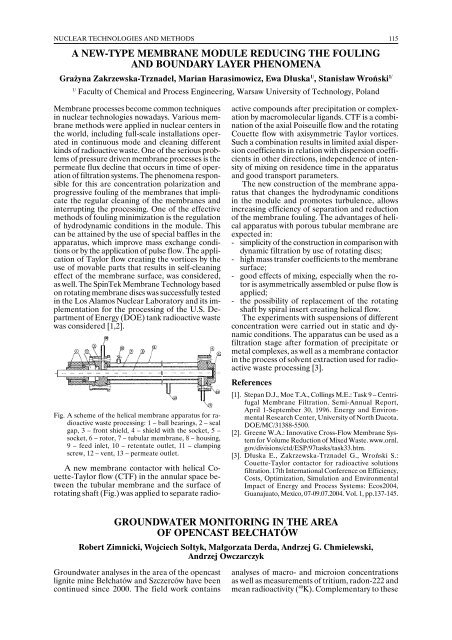annual report annual report annual report annual report 2005
annual report annual report annual report annual report 2005
annual report annual report annual report annual report 2005
You also want an ePaper? Increase the reach of your titles
YUMPU automatically turns print PDFs into web optimized ePapers that Google loves.
NUCLEAR TECHNOLOGIES AND METHODS 115<br />
A NEW-TYPE MEMBRANE MODULE REDUCING THE FOULING<br />
AND BOUNDARY LAYER PHENOMENA<br />
Grażyna Zakrzewska-Trznadel, Marian Harasimowicz, Ewa Dłuska 1/ , Stanisław Wroński 1/<br />
1/<br />
Faculty of Chemical and Process Engineering, Warsaw University of Technology, Poland<br />
Membrane processes become common techniques<br />
in nuclear technologies nowadays. Various membrane<br />
methods were applied in nuclear centers in<br />
the world, including full-scale installations operated<br />
in continuous mode and cleaning different<br />
kinds of radioactive waste. One of the serious problems<br />
of pressure driven membrane processes is the<br />
permeate flux decline that occurs in time of operation<br />
of filtration systems. The phenomena responsible<br />
for this are concentration polarization and<br />
progressive fouling of the membranes that implicate<br />
the regular cleaning of the membranes and<br />
interrupting the processing. One of the effective<br />
methods of fouling minimization is the regulation<br />
of hydrodynamic conditions in the module. This<br />
can be attained by the use of special baffles in the<br />
apparatus, which improve mass exchange conditions<br />
or by the application of pulse flow. The application<br />
of Taylor flow creating the vortices by the<br />
use of movable parts that results in self-cleaning<br />
effect of the membrane surface, was considered,<br />
as well. The SpinTek Membrane Technology based<br />
on rotating membrane discs was successfully tested<br />
in the Los Alamos Nuclear Laboratory and its implementation<br />
for the processing of the U.S. Department<br />
of Energy (DOE) tank radioactive waste<br />
was considered [1,2].<br />
Fig. A scheme of the helical membrane apparatus for radioactive<br />
waste processing: 1 – ball bearings, 2 – seal<br />
gap, 3 – front shield, 4 – shield with the socket, 5 –<br />
socket, 6 – rotor, 7 – tubular membrane, 8 – housing,<br />
9 – feed inlet, 10 – retentate outlet, 11 – clamping<br />
screw, 12 – vent, 13 – permeate outlet.<br />
A new membrane contactor with helical Couette-Taylor<br />
flow (CTF) in the annular space between<br />
the tubular membrane and the surface of<br />
rotating shaft (Fig.) was applied to separate radioactive<br />
compounds after precipitation or complexation<br />
by macromolecular ligands. CTF is a combination<br />
of the axial Poiseuille flow and the rotating<br />
Couette flow with axisymmetric Taylor vortices.<br />
Such a combination results in limited axial dispersion<br />
coefficients in relation with dispersion coefficients<br />
in other directions, independence of intensity<br />
of mixing on residence time in the apparatus<br />
and good transport parameters.<br />
The new construction of the membrane apparatus<br />
that changes the hydrodynamic conditions<br />
in the module and promotes turbulence, allows<br />
increasing efficiency of separation and reduction<br />
of the membrane fouling. The advantages of helical<br />
apparatus with porous tubular membrane are<br />
expected in:<br />
- simplicity of the construction in comparison with<br />
dynamic filtration by use of rotating discs;<br />
- high mass transfer coefficients to the membrane<br />
surface;<br />
- good effects of mixing, especially when the rotor<br />
is asymmetrically assembled or pulse flow is<br />
applied;<br />
- the possibility of replacement of the rotating<br />
shaft by spiral insert creating helical flow.<br />
The experiments with suspensions of different<br />
concentration were carried out in static and dynamic<br />
conditions. The apparatus can be used as a<br />
filtration stage after formation of precipitate or<br />
metal complexes, as well as a membrane contactor<br />
in the process of solvent extraction used for radioactive<br />
waste processing [3].<br />
References<br />
[1]. Stepan D.J., Moe T.A., Collings M.E.: Task 9 – Centrifugal<br />
Membrane Filtration. Semi-Annual Report,<br />
April 1-September 30, 1996. Energy and Environmental<br />
Research Center, University of North Dacota.<br />
DOE/MC/31388-5500.<br />
[2]. Greene W.A.: Innovative Cross-Flow Membrane System<br />
for Volume Reduction of Mixed Waste. www.ornl.<br />
gov/divisions/ctd/ESP/97tasks/task33.htm.<br />
[3]. Dłuska E., Zakrzewska-Trznadel G., Wroński S.:<br />
Couette-Taylor contactor for radioactive solutions<br />
filtration. 17th International Conference on Efficiency,<br />
Costs, Optimization, Simulation and Environmental<br />
Impact of Energy and Process Systems: Ecos2004,<br />
Guanajuato, Mexico, 07-09.07.2004. Vol. 1, pp.137-145.<br />
GROUNDWATER MONITORING IN THE AREA<br />
OF OPENCAST BEŁCHATÓW<br />
Robert Zimnicki, Wojciech Sołtyk, Małgorzata Derda, Andrzej G. Chmielewski,<br />
Andrzej Owczarczyk<br />
Groundwater analyses in the area of the opencast<br />
lignite mine Bełchatów and Szczerców have been<br />
continued since 2000. The field work contains<br />
analyses of macro- and microion concentrations<br />
as well as measurements of tritium, radon-222 and<br />
mean radioactivity ( 40 K). Complementary to these
















